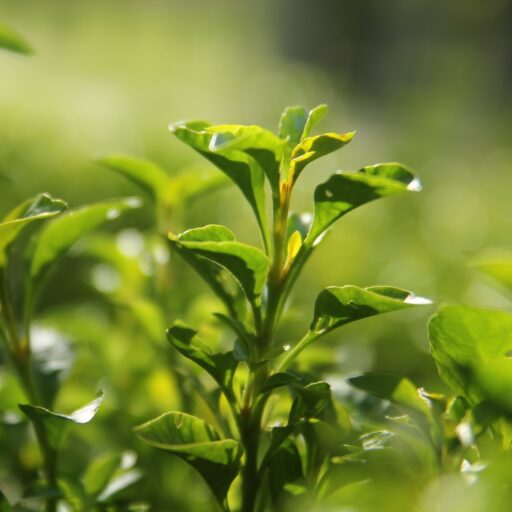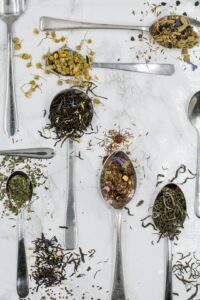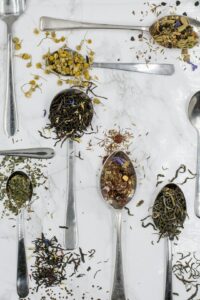Support our educational content for free when you purchase through links on our site. Learn more
Can I Grow My Own Tea Tree? The Ultimate Guide to Growing Tea Plants at Home [2023]
Just a sip of tea can transport you to a world of calm and serenity. But have you ever wondered if you can grow your own tea tree and brew your own cup of tea at home? Well, you're in luck! Our team of expert tea growers at Growing Teas™ is here to guide you on how to grow your own tea plants right in your own backyard. In this comprehensive guide, we'll cover everything you need to know about growing tea plants, from the different types of tea plants to planting and harvesting methods. So grab your gardening gloves and let's dive in!
Table of Contents
- Learn from the Best
- What is a Tea Plant?
- The Various Types of Tea Plants
- How Tea is Grown
- Planting Tea in 7 Simple Steps
- Harvesting and Processing Your Tea
- 7 Tips for Growing Tea Successfully
- Frequently Asked Questions
- Quick Tips and Facts
- Useful Links
- Reference Links
Learn from the Best
Before we embark on this exciting journey of growing tea plants at home, let's take a moment to learn from the best. There are countless tea plantations around the world that have perfected the art of growing tea plants, and we can certainly draw inspiration from their expertise. Take a virtual tour of tea plantations, read books on tea cultivation, or enroll in our Home & Lifestyle courses to learn from seasoned tea growers. By immersing yourself in their knowledge and experience, you'll gain a deeper understanding of the fascinating world of tea cultivation.
What is a Tea Plant?
To truly appreciate the art of growing tea plants, it's important to understand what a tea plant is. The tea plant, scientifically known as Camellia sinensis, is an evergreen shrub native to East Asia. It is the source of all true teas, including green tea, black tea, white tea, oolong tea, and pu-erh tea. The leaves of the tea plant are carefully harvested, processed, and brewed to create the diverse array of teas we know and love.
The Various Types of Tea Plants
Tea plants can be classified into two main types based on their processing methods: Camellia sinensis var. sinensis and Camellia sinensis var. assamica. These two varieties differ in their leaf characteristics, flavor profiles, and growing conditions.
Camellia sinensis var. sinensis
Camellia sinensis var. sinensis is the most common variety of tea plant, often referred to as the Chinese tea plant. It has smaller leaves, thrives in cooler temperatures, and is generally grown at higher altitudes. This variety is used to produce many popular teas, including green tea, white tea, and some black teas. The delicate and nuanced flavors of teas made from this variety are highly prized by tea connoisseurs.
Camellia sinensis var. assamica
Camellia sinensis var. assamica, also known as the Assam tea plant, is native to the Indian state of Assam. It has larger leaves, adapts well to warmer climates, and is often cultivated at lower altitudes. This variety is primarily used for black teas, including the famous Assam tea. Teas made from these leaves are robust and full-bodied, with a malty flavor.
How Tea is Grown
Now that we know the basics of tea plants, let's take a closer look at how these beautiful shrubs are grown. Growing tea requires specific environmental conditions, careful cultivation techniques, and a dash of patience. Here are the key steps involved in the tea-growing process:
Step 1: Choosing the Right Location
Tee plantso prefer well-drained soil, ample sunlight, and a climate with moderate temperatures. Before you start planting, find a spot in your garden that fulfills these requirements. Consider the local climate, as some tea plants thrive in cooler regions while others prefer warmer conditions.
Step 2: Soil Preparation
Preparing the soil is essential for the optimal growth of tea plants. Ideally, the soil should be slightly acidic, with a pH range of 6 to 6.5. Test the soil's pH level and make necessary adjustments by adding organic matter or suitable soil amendments.
Step 3: Obtaining Tea Plant Seedlings
To kickstart your tea garden, you can either purchase tea plant seedlings or propagate them from cuttings. Many nurseries and online suppliers offer tea plant seedlings that are ready to be transplanted into your garden. Alternatively, you can take cuttings from existing tea plants, rooting them in a suitable growing medium.
Step 4: Planting the Tea Seedlings
Once you have your tea plant seedlings or cuttings, it's time to plant them in your prepared soil. Dig a hole slightly larger than the root ball of the seedling and ensure it is planted at the same depth as it was in the container or nursery. Gently tamp down the soil around the plant and water thoroughly.
Step 5: Watering and Fertilizing
Consistent watering is crucial for the healthy growth of tea plants. Water your tea plants regularly, keeping the soil evenly moist but not waterlogged. During dry spells or hot weather, increase the frequency of watering. Additionally, apply a balanced organic fertilizer once every two to three months to provide essential nutrients.
Step 6: Pruning and Shaping
Pruning helps tea plants maintain their shape, improve air circulation, and promote new growth. In the first few years, focus on removing any dead or diseased branches and shaping the plant. As the plant matures, continue thinning out dense growth and maintaining a manageable size.
Step 7: Pest and Disease Control
Like any other plant, tea plants are susceptible to pests and diseases. Keep an eye out for common tea pests such as aphids, mealybugs, and mites. Use organic pest control methods or repellents to protect your tea plants. Regularly inspect your plants for signs of disease, and take appropriate steps to address any issues.
Planting Tea in 7 Simple Steps
Planting tea may seem like a daunting task, but with the right knowledge and a little bit of patience, anyone can grow their own tea plants at home. Follow these 7 simple steps to get started on your tea-growing journey:
- Choose the Right Variety: Determine whether you want to grow Camellia sinensis var. sinensis or Camellia sinensis var. assamica, based on your climate and preferences.
- Prepare the Soil: Test the soil's pH level and make necessary adjustments to create a slightly acidic environment (pH 6-6.5). Incorporate organic matter or soil amendments as needed.
- Obtain Tea Plant Seedlings: Purchase tea plant seedlings from reputable nurseries or online suppliers, or propagate your own from cuttings.
- Plant the Seedlings: Dig a hole slightly larger than the root ball of the seedling and place it at the same depth it was in the container or nursery. Gently backfill the hole with soil and water thoroughly.
- Provide Adequate Care: Water your tea plants regularly, keeping the soil evenly moist. Apply a balanced organic fertilizer every 2-3 months to provide essential nutrients.
- Prune and Shape: Prune your tea plants to maintain shape, improve air circulation, and promote new growth. Remove any dead or diseased branches, and thin out dense growth as needed.
- Monitor for Pests and Diseases: Regularly inspect your tea plants for pests and diseases. Use organic pest control methods and take immediate action to address any issues.
Following these steps will set you on the path to successfully growing your own tea plants at home. Remember to be patient, as tea plants take time to mature and yield leaves suitable for harvesting.
Harvesting and Processing Your Tea
After months of nurturing your tea plants, the time will finally come to harvest and process your own tea leaves. This exhilarating step allows you to fully immerse yourself in the tea-making process and enjoy the fruits of your labor. Here's how it's done:
- Timing the Harvest: The ideal time to harvest tea leaves varies depending on the type of tea you wish to produce. For green and white teas, harvest the young and tender leaves. For black and oolong teas, allow the leaves to mature slightly before harvesting.
- Plucking the Leaves: Carefully pluck the tea leaves, selecting only the top two to three leaves and the bud. Be gentle to avoid damaging the plant and ensure the leaves stay intact.
- Withering: Spread the freshly plucked leaves in a shaded area, away from direct sunlight. Allow them to wither for a few hours, which helps reduce moisture content and initiates the tea oxidation process.
- Rolling and Shaping: Roll the withered leaves gently by hand or using a rolling machine. This step breaks the cell walls and releases enzymes, which leads to oxidation and flavor development. Shaping the leaves into a desired form is also done during this process.
- Oxidation: Depending on the type of tea, oxidation can range from minimal (green teas) to extensive (black teas). Allow the rolled leaves to oxidize by exposing them to controlled humidity and temperature conditions. This step is crucial for the development of flavors and aromas.
- Drying and Fixing: Once the desired level of oxidation is achieved, apply heat to stop the oxidation process by drying and fixing the leaves. This step preserves the flavors and aromas, and also ensures the tea is safe for consumption.
- Final Processing: After drying, the tea leaves may go through additional processing steps such as sorting, grading, and packaging, depending on the desired end product.
Harvesting and processing tea leaves is an art that requires skill and a deep understanding of the desired tea type. Experiment with different techniques, processes, and timing to create unique flavors and aromas that reflect your personal taste.
7 Tips for Growing Tea Successfully
Now that you're armed with the knowledge of tea cultivation, we'd like to share some expert tips to help you grow tea successfully at home. These tips will not only enhance the health and productivity of your tea plants but also ensure a rewarding tea-growing experience. Here are our top 7 tips:
- Choose the Right Variety and Location: Select the appropriate tea variety based on your climate and preferences. Find a sunny spot with well-drained soil for the optimal growth of your tea plants.
- Soil Preparation is Key: Test the soil's pH level and ensure it falls within the ideal range of 6-6.5. Add organic matter or appropriate soil amendments to improve the soil's fertility and drainage.
- Water Consistently: Tea plants require consistent moisture. Water your tea plants regularly, ensuring the soil is evenly moist but not waterlogged. Increase the frequency of watering during dry spells.
- Feed with Organic Fertilizers: Apply a balanced organic fertilizer every two to three months to provide essential nutrients. Avoid over-fertilization, as it can lead to excessive foliage growth at the expense of tea leaf production.
- Prune and Maintain Shape: Regularly prune your tea plants to maintain their shape, improve air circulation, and remove dead or diseased branches. Pruning encourages new growth and ensures better leaf quality.
- Keep Pests and Diseases at Bay: Monitor your tea plants for pests and diseases regularly. Use organic pest control methods and take immediate action to prevent infestation or the spread of diseases.
- Patience is a Virtue: Growing tea plants takes time and patience. Be prepared to wait for a few years before your tea plants reach maturity and produce leaves suitable for harvesting. Enjoy the process and savor the anticipation!
By following these expert tips, you'll be well on your way to becoming a successful tea grower, delighting in the satisfaction of growing your own tea right in your own backyard.
Frequently Asked Questions
Can tea trees be grown in the US?
Absolutely! Tea trees can be grown in the United States, particularly in regions with suitable climates. While regions like Hawaii and parts of the Pacific Northwest are favored for commercial tea cultivation, with the right conditions, tea can be grown in various other states as well. It's important to choose the right tea variety and ensure it receives the necessary care and attention.
How do you grow tea trees at home?
To grow tea trees at home, start by choosing the appropriate tea variety based on your climate and preferences. Prepare the soil by testing its pH level and making necessary adjustments. Obtain tea plant seedlings or cuttings and plant them in well-drained soil. Provide consistent watering, fertilize regularly, and prune to maintain shape. Monitor for pests and diseases, and be patient as it takes time for tea plants to mature and produce leaves suitable for harvest.
How long does a tea tree take to grow?
The time it takes for a tea tree to grow and reach maturity depends on various factors, including the tea variety, growing conditions, and cultivation techniques. On average, it can take several years, typically around 3 to 5 years, for tea plants to mature and produce leaves suitable for harvesting. However, it's important to note that you can start harvesting leaves for certain tea types, like green tea, from younger plants.
Quick Tips and Facts
- Tea plants prefer well-drained soil, ample sunlight, and moderate temperatures.
- The tea plant, known as Camellia sinensis, is the source of all true teas.
- There are two main types of tea plants: Camellia sinensis var. sinensis and Camellia sinensis var. assamica.
- Camellia sinensis var. sinensis is prized for delicate and nuanced flavors.
- Camellia sinensis var. assamica produces robust and full-bodied teas.
- Tea plants take time to mature, so be patient and enjoy the process.
- The ideal pH range for tea plants is 6-6.5.
- Tea leaves are harvested at different stages of growth to produce various types of teas.
- Proper pruning helps tea plants maintain shape and promote new growth.
- Organic pest control methods are recommended for tea plants.
Useful Links
- Growing Teas™
- Tea Growing Courses
- Tea Plant Varieties for Sale (Amazon)
- Tea Plant Seeds for Sale (Etsy)
- Books on Tea Cultivation (Amazon)
Explore these useful links for additional information on tea cultivation, purchasing tea plant varieties, and books to deepen your knowledge of tea growing.
Reference Links
This comprehensive guide to growing tea at home was compiled using information from various reliable sources, including Wikipedia and the Royal Horticultural Society.







